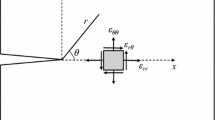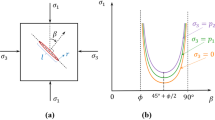Abstract
Understanding the size dependence of quasi-brittle materials' fracture behavior is useful in assessing the safety of flawed rock engineering structures. In this study, a set of uniaxial compression tests were conducted to scrutinize the mechanical properties and crack morphology of cubic specimens with sizes of 75 mm, 100 mm, 125 mm and 150 mm. The results showed that the specimens had significant size dependence in terms of strength and crack initiation angle. The crack type and fracture pattern were not affected by the specimen size and were mainly controlled by the pre-existing crack inclination angle. Next, the test results were compared with the maximum tangential stress criterion considering the T-stress. The results also showed that the crack initiation angles of specimens with different sizes were in good agreement with the theoretical calculations. The non-singular compressive stress perpendicular to the crack surface inhibited the generation of the fracture process zone (FPZ). In addition, the stress required for tensile failure was smaller for large-size specimens, leading to a decrease in the length of the FPZ with increasing specimen size. The FPZ variation law of the uniaxial compression tests was greatly different from that of the mode I loading.

















Similar content being viewed by others
References
Ayatollahi, M.R., Akbardoost, J.: Size effects in mode II brittle fracture of rocks. Eng. Fract. Mech. 112–113, 165–180 (2013). https://doi.org/10.1016/j.engfracmech.2013.10.011
Petit, J.-P., Barquins, M.: Can natural faults propagate under Mode II conditions? Tectonics 7, 1243–1256 (1988). https://doi.org/10.1029/TC007i006p01243
Ozbolt, J., Eligehausen, R., Petrangeli, M.: Size Effect in Concrete Structures. University of Stuttgart, Stuttgart (1994)
ASTM Standard E399-12. Standard test method for linear-elastic plane-strain fracture toughness KIC of metallic materials. Annual book of ASTM standards. West Conshohocken, PA: ASTM International; 2013.
Kuruppu, M.D., Obara, Y., Ayatollahi, M.R., et al.: ISRM-suggested method for determining the Mode I static fracture toughness using semi-circular bend specimen. Rock Mech. Rock Eng. 47, 267–274 (2014). https://doi.org/10.1007/s00603-013-0422-7
Aliha, M.R.M., Ashtari, R., Ayatollahi, M.R.: Mode I and Mode II fracture toughness testing for a coarse grain marble. Appl. Mech. Mater. 5–6, 181–188 (2006). https://doi.org/10.4028/www.scientific.net/AMM.5-6.181
Wang, J.-J., Huang, S.-Y., Hu, J.-F.: Limit of crack depth in KIC testing for a clay. Eng. Fract. Mech. 164, 19–23 (2016). https://doi.org/10.1016/j.engfracmech.2016.08.006
Suits, L.D., Sheahan, T.C., Wang, J.-J., et al.: Experimental study on fracture behavior of a silty clay. Geotech. Test. J. 30, 100715 (2007). https://doi.org/10.1520/GTJ100715
Wang, J., Huang, S., Guo, W., et al.: Experimental study on fracture toughness of a compacted clay using semi-circular bend specimen. Eng. Fract. Mech. 224, 106814 (2020). https://doi.org/10.1016/j.engfracmech.2019.106814
Chong, K.P., Kuruppu, M.D.: New specimen for fracture toughness determination for rock and other materials. Int. J. Fract. 26, R59–R62 (1984). https://doi.org/10.1007/BF01157555
Aliha, M.R.M., Ayatollahi, M.R., Smith, D.J., et al.: Geometry and size effects on fracture trajectory in a limestone rock under mixed mode loading. Eng. Fract. Mech. 77, 2200–2212 (2010). https://doi.org/10.1016/j.engfracmech.2010.03.009
Zhang, S., An, D., Zhang, X., et al.: Research on size effect of fracture toughness of sandstone using the center-cracked circular disc samples. Eng. Fract. Mech. 251, 107777 (2021). https://doi.org/10.1016/j.engfracmech.2021.107777
Bažant, Z.P., Gettu, R., Kazemi, M.T.: Identification of nonlinear fracture properties from size effect tests and structural analysis based on geometry-dependent R-curves. Int. J. Rock Mech. Min. Sci. Geomech. Abstr. 28, 43–51 (1991). https://doi.org/10.1016/0148-9062(91)93232-U
Ayatollahi, M.R., Akbardoost, J.: Size and geometry effects on rock fracture toughness: mode I fracture. Rock Mech. Rock Eng. 47, 677–687 (2014). https://doi.org/10.1007/s00603-013-0430-7
Ayatollahi, M.R., Akbardoost, J.: Size effects on fracture toughness of quasi-brittle materials—a new approach. Eng. Fract. Mech. 92, 89–100 (2012). https://doi.org/10.1016/j.engfracmech.2012.06.005
Hoover, C.G., Bažant, Z.P.: Universal size-shape effect law based on comprehensive concrete fracture tests. J. Eng. Mech. 140, 473–479 (2014). https://doi.org/10.1061/(ASCE)EM.1943-7889.0000627
Bažant, Z.P.: Size effect in blunt fracture: concrete, rock, metal. J. Eng. Mech. 110, 518–535 (1984). https://doi.org/10.1061/(ASCE)0733-9399(1984)110:4(518)
Karamloo, M., Mazloom, M.: An efficient algorithm for scaling problem of notched beam specimens with various notch to depth ratios. Comput. Concr. 22, 39–51 (2018). https://doi.org/10.12989/CAC.2018.22.1.039
Erarslan, N.: Microstructural investigation of subcritical crack propagation and Fracture Process Zone (FPZ) by the reduction of rock fracture toughness under cyclic loading. Eng. Geol. 208, 181–190 (2016). https://doi.org/10.1016/j.enggeo.2016.04.035
Hillerborg, A., Modéer, M., Petersson, P.E.: Analysis of crack formation and crack growth in concrete by means of fracture mechanics and finite elements. Cem. Concr. Res. 6, 773–781 (1976). https://doi.org/10.1016/0008-8846(76)90007-7
Akbardoost, J., Ayatollahi, M.R.: Experimental analysis of mixed mode crack propagation in brittle rocks: the effect of non-singular terms. Eng. Fract. Mech. 129, 77–89 (2014). https://doi.org/10.1016/j.engfracmech.2014.05.016
Karihaloo, L.B.: Size effect in shallow and deep notched quasi-brittle structures. Int. J. Fract. (1999). https://doi.org/10.1023/A:1018633208621
Awaji, H., Sato, S.: Combined mode fracture toughness measurement by the disk test. J. Eng. Mater. Technol. 100, 175–182 (1978). https://doi.org/10.1115/1.3443468
Chang, S.H., Lee, C.I., Jeon, S.: Measurement of rock fracture toughness under modes I and II and mixed-mode conditions by using disc-type specimens. Eng. Geol. 66, 79–97 (2002). https://doi.org/10.1016/S0013-7952(02)00033-9
Bazant, Z., Planas, J.: Fracture Size Effect in Concrete and Other Quasi-brittle Materials. Epfl (1997)
Xing, Y., Huang, B., Ning, E., Zhao, L., et al.: Quasi-static loading rate effects on fracture process zone development of mixed-mode (I-II) fractures in rock-like materials. Eng. Fract. Mech. 240, 107365 (2020). https://doi.org/10.1016/j.engfracmech.2020.107365
Yang, S.Q., Jing, H.W.: Strength failure and crack coalescence behavior of brittle sandstone samples containing a single fissure under uniaxial compression. Int. J. Fract. 168, 227–250 (2011). https://doi.org/10.1007/s10704-010-9576-4
Miao, S., Pan, P.Z., Wu, Z., et al.: Fracture analysis of sandstone with a single filled flaw under uniaxial compression. Eng. Fract. Mech. 204, 319–343 (2018). https://doi.org/10.1016/j.engfracmech.2018.10.009
Li, H., Wong, L.: Influence of flaw inclination angle and loading condition on crack initiation and propagation. Int. J. Solids Struct. 49(18), 2482–2499 (2012). https://doi.org/10.1016/j.ijsolstr.2012.05.012
Yang, S.Q., Dai, Y.H., Han, L.J., et al.: Experimental study on mechanical behavior of brittle marble samples containing different flaws under uniaxial compression. Eng. Fract. Mech. 76(12), 1833–1845 (2009). https://doi.org/10.1016/j.engfracmech.2009.04.005
Marji, M.F.: A bonded particle model for analysis of the flaw orientation effect on crack propagation mechanism in brittle materials under compression. Arch. Civ. Mech. Eng. 14(1), 40–52 (2014). https://doi.org/10.1016/j.acme.2013.05.008
Cheng, H., Zhou, X., Zhu, J., et al.: The effects of crack openings on crack initiation, propagation and coalescence behavior in rock-like materials under uniaxial compression. Rock Mech. Rock Eng. 49(9), 1–14 (2016). https://doi.org/10.1007/s00603-016-0998-9
Gratchev, I., Kim, D.H., Yeung, C.K.: Strength of rock-like specimens with pre-existing cracks of different length and width. Rock Mech. Rock Eng. 49(11), 1–6 (2016). https://doi.org/10.1007/s00603-016-1013-1
Xu, J., Li, Z., et al.: Damage evolution and crack propagation in rocks with dual elliptic flaws in compression. Acta Mech. Solida Sin. (2017). https://doi.org/10.1016/j.camss.2017.11.001
Zhang, J.-Z., Zhou, X.-P.: Fracture process zone (FPZ) in quasi-brittle materials: review and new insights from flawed granite subjected to uniaxial stress. Eng. Fract. Mech. 274, 108795 (2022). https://doi.org/10.1016/j.engfracmech.2022.108795
Erdogan, F., Sih, G.C.: On the crack extension in plates under plane loading and transverse shear. J. Basic Eng. 85, 519–525 (1963). https://doi.org/10.1115/1.3656897
Williams, M.L.: On the stress distribution at the base of a stationary crack. J. Appl. Mech. 24, 109–114 (1957). https://doi.org/10.1115/1.4011454
Ren, L., Zhu, Z., Wang, M., Zheng, T., Ai, T.: Mixed-mode elastic-plastic fractures: improved R-criterion. J. Eng. Mech. 140, 04014033 (2014). https://doi.org/10.1061/(ASCE)EM.1943-7889.0000755
Zhang, X.-P., Wong, L.N.Y.: Cracking processes in rock-like material containing a single flaw under uniaxial compression: a numerical study based on parallel bonded-particle model approach. Rock Mech. Rock Eng. (2011). https://doi.org/10.1007/s00603-011-0176-z
Williams, J.G., Ewing, P.D.: Fracture under complex stress—the angled crack problem. Int. J. Fract. 26, 346–351 (1984). https://doi.org/10.1007/BF00962967
Gupta, M., Alderliesten, R.C., Benedictus, R.: A review of T-stress and its effects in fracture mechanics. Eng. Fract. Mech. 134, 218–241 (2015). https://doi.org/10.1016/j.engfracmech.2014.10.013
Smith, D.J., Ayatollahi, M.R., Pavier, M.J.: The role of T-stress in brittle fracture for linear elastic materials under mixed-mode loading: BRITTLE FRACTURE IN MIXED MODE CONDITIONS. Fatigue Fract. Eng. Mater. Struct. 24, 137–150 (2001). https://doi.org/10.1046/j.1460-2695.2001.00377.x
Tang, S.B., Bao, C.Y., Liu, H.Y.: Brittle fracture of rock under combined tensile and compressive loading conditions. Can. Geotech. J. 54, 88–101 (2017). https://doi.org/10.1139/cgj-2016-0214
Zheng, T., Zhu, Z., Wang, B., Zeng, L.: Stress intensity factor for an infinite plane containing three collinear cracks under compression: an infinite plane containing three collinear cracks. ZAMM-J. Appl. Math. Mech. Z. Für Angew. Math. Mech. 94, 853–861 (2014). https://doi.org/10.1002/zamm.201300001
Ayatollahi, M.R., Aliha, M.R.M.: H, Saghafi, An improved semi-circular bend specimen for investigating mixed mode brittle fracture. Eng. Fract. Mech. 78, 110–123 (2011). https://doi.org/10.1016/j.engfracmech.2010.10.001
Aliha, M.R.M., Bahmani, A., Akhondi, Sh.: Mixed mode fracture toughness testing of PMMA with different three-point bend type specimens. Eur. J. Mech. ASolids. 58, 148–162 (2016). https://doi.org/10.1016/j.euromechsol.2016.01.012
Aliha, M.R.M., JafariHaghighatpour, P., Tavana, A.: Application of asymmetric semi-circular bend test for determining mixed mode I+II fracture toughness of compacted soil material. Eng. Fract. Mech. 262, 108268 (2022). https://doi.org/10.1016/j.engfracmech.2022.108268
Zhang, J., Zhou, X.: Forecasting catastrophic rupture in brittle rocks using precursory AE time series. J. Geophys. Res. Solid Earth (2020). https://doi.org/10.1029/2019JB019276
Zhang, J.-Z., Zhou, X.-P.: AE event rate characteristics of flawed granite: from damage stress to ultimate failure. Geophys. J. Int. 222, 795–814 (2020). https://doi.org/10.1093/gji/ggaa207
Zhang, J., Zhou, X., Zhou, L., Berto, F.: Progressive failure of brittle rocks with non-isometric flaws: insights from acousto-optic-mechanical (AOM) data. Fatigue Fract. Eng. Mater. Struct. 42, 1787–1802 (2019). https://doi.org/10.1111/ffe.13019
Zhou, X.-P., Zhang, J.-Z., Wong, L.N.Y.: Experimental study on the growth, coalescence and wrapping behaviors of 3D cross-embedded flaws under uniaxial compression. Rock Mech. Rock Eng. 51, 1379–1400 (2018). https://doi.org/10.1007/s00603-018-1406-4
Wong, L., Einstein, H.H.: Systematic evaluation of cracking behavior in specimens containing single flaws under uniaxial compression. Int. J. Rock Mech. Min. Sci. 46, 239–249 (2009). https://doi.org/10.1016/j.ijrmms.2008.03.006
Zhou, X.-P., Zhang, J.-Z.: Damage progression and acoustic emission in brittle failure of granite and sandstone. Int. J. Rock Mech. Min. Sci. 143, 104789 (2021). https://doi.org/10.1016/j.ijrmms.2021.104789
Fan, Y., Zhu, Z., Zhao, Y., et al.: Analytical solution of T-stresses for an inclined crack in compression. Int. J. Rock Mech. Min. Sci. 138, 104433 (2021). https://doi.org/10.1016/j.ijrmms.2020.104433
Cotterell, B.: Brittle fracture in compression. Int. J. Fract. Mech. 8, 195–208 (1972). https://doi.org/10.1007/BF00703881
Chaker, C., Barquins, M.: Sliding effect on branch crack. Phys. Chem. Earth 21, 319–323 (1996). https://doi.org/10.1016/S0079-1946(97)00055-4
Huang, S.Y., Wang, J.J., Wang, A.G., et al.: Fracture failure mechanism and fracture criterion of compacted clay under compression and shear action. Chin. J. Geotech. Eng. 43(3), 492–501 (2021). https://doi.org/10.11779/CJGE202103012
Thiercelin, M., Roegiers, J.C.: Fracture toughness determination with the modified ring test. In: Proceedings of the International Symposium on Engineering in Complex Rock Formations, pp. 284–290. Elsevier (1988). https://doi.org/10.1016/B978-0-08-035894-9.50041-X
Zhou, X.P., Cheng, H., Feng, Y.F.: An experimental study of crack coalescence behaviour in rock-like materials containing multiple flaws under uniaxial compression. Rock Mech. Rock Eng. 47, 1961–1986 (2014). https://doi.org/10.1007/s00603-013-0511-7
Zhang, S., Wang, H., Li, X., et al.: Experimental study on development characteristics and size effect of rock fracture process zone. Eng. Fract. Mech. 241, 107377 (2021). https://doi.org/10.1016/j.engfracmech.2020.107377
Acknowledgements
This work was supported by the Science and Technology Research Program of Chongqing Municipal Education Commission (Grant No. KJZD-K202000705), the A Project of Innovation and Development Joint Fund of Chongqing Natural Science Foundation (Municipal Education Commission) (CSTB2022NSCQ-LZX0049), the National Natural Science Foundation of China (52109113), the Natural Science Foundation on the project of Chongqing (cstc2021jcyj-msxmX1114), and the Ministry of Water Conservancy Embankment Safety and Disease Prevention Engineering Technology Research Center Open Subject Fund Funded Projects (LSDP202101).
Author information
Authors and Affiliations
Corresponding author
Ethics declarations
Conflict of interest
On behalf of all authors, the corresponding author states that there is no conflict of interest.
Additional information
Publisher's Note
Springer Nature remains neutral with regard to jurisdictional claims in published maps and institutional affiliations.
Rights and permissions
Springer Nature or its licensor (e.g. a society or other partner) holds exclusive rights to this article under a publishing agreement with the author(s) or other rightsholder(s); author self-archiving of the accepted manuscript version of this article is solely governed by the terms of such publishing agreement and applicable law.
About this article
Cite this article
Wang, J., Lv, C., Huang, S. et al. Size effect on fracture behavior of quasi-brittle materials during uniaxial compression tests. Arch Appl Mech 93, 3171–3188 (2023). https://doi.org/10.1007/s00419-023-02431-2
Received:
Accepted:
Published:
Issue Date:
DOI: https://doi.org/10.1007/s00419-023-02431-2




